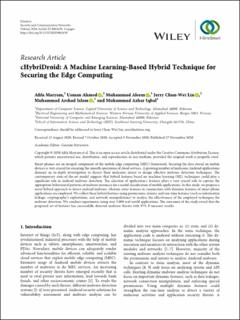| dc.contributor.author | Maryam, Afifa | |
| dc.contributor.author | Ahmed, Usman | |
| dc.contributor.author | Aleem, Muhammad | |
| dc.contributor.author | Lin, Jerry Chun-Wei | |
| dc.contributor.author | Muhammad Arshad, Islam | |
| dc.contributor.author | Iqbal, Muhammad Azhar | |
| dc.date.accessioned | 2021-03-15T07:45:46Z | |
| dc.date.available | 2021-03-15T07:45:46Z | |
| dc.date.created | 2021-01-14T21:22:52Z | |
| dc.date.issued | 2020 | |
| dc.identifier.citation | Maryam, A., Ahmed, U., Aleem, M., Lin, J. C.-W., Arshad Islam, M., Iqbal, M. A., & Srivastava, G. (2020). cHybriDroid: A Machine Learning-Based Hybrid Technique for Securing the Edge Computing. Security and Communication Networks, 2020, 8861639. | en_US |
| dc.identifier.issn | 1939-0114 | |
| dc.identifier.uri | https://hdl.handle.net/11250/2733267 | |
| dc.description.abstract | Smart phones are an integral component of the mobile edge computing (MEC) framework. Securing the data stored on mobile devices is very crucial for ensuring the smooth operations of cloud services. A growing number of malicious Android applications demand an in-depth investigation to dissect their malicious intent to design effective malware detection techniques. The contemporary state-of-the-art model suggests that hybrid features based on machine learning (ML) techniques could play a significant role in android malware detection. The selection of application’s features plays a very crucial role to capture the appropriate behavioural patterns of malware instances for a useful classification of mobile applications. In this study, we propose a novel hybrid approach to detect android malware, wherein static features in conjunction with dynamic features of smart phone applications are employed. We collect these hybrid features using permissions, intents, and run-time features (such as information leakage, cryptography’s exploitation, and network manipulations) to analyse the effectiveness of the employed techniques for malware detection. We conduct experiments using over 5,000 real-world applications. The outcomes of the study reveal that the proposed set of features has successfully detected malware threats with 97% F-measure results. | en_US |
| dc.language.iso | eng | en_US |
| dc.publisher | Hindawi | en_US |
| dc.rights | Navngivelse 4.0 Internasjonal | * |
| dc.rights.uri | http://creativecommons.org/licenses/by/4.0/deed.no | * |
| dc.title | cHybriDroid: A Machine Learning-Based Hybrid Technique for Securing the Edge Computing | en_US |
| dc.type | Journal article | en_US |
| dc.type | Peer reviewed | en_US |
| dc.description.version | publishedVersion | en_US |
| dc.rights.holder | Copyright © 2020 Afifa Maryam et al. | en_US |
| dc.subject.nsi | VDP::Technology: 500::Information and communication technology: 550 | en_US |
| dc.source.volume | 2020 | en_US |
| dc.source.journal | Security and Communication Networks | en_US |
| dc.identifier.doi | 10.1155/2020/8861639 | |
| dc.identifier.cristin | 1871658 | |
| dc.source.articlenumber | 8861639 | en_US |
| cristin.ispublished | true | |
| cristin.fulltext | original | |
| cristin.qualitycode | 1 | |

